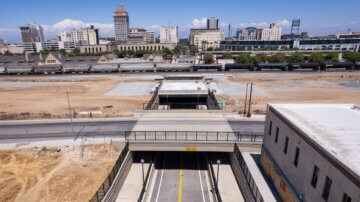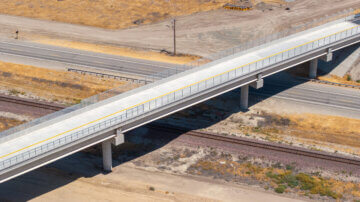|
Noticias importantes |
Actualizaciones de socios |
Actualizaciones de divulgación |
California avanza con un acuerdo de financiación estable para el tren de alta velocidad.

El gobernador Newsom pronuncia un discurso en la ceremonia de firma de la legislación que prorrogó el programa de límites máximos de emisiones e inversiones de California.
El 19 de septiembre, el gobernador Gavin Newsom firmó un acuerdo negociado con la Legislatura estatal para reautorizar el programa de límites máximos de emisiones e inversiones y proporcionar un compromiso histórico de 1.500 millones de dólares anuales para la Autoridad del Tren de Alta Velocidad de California (Autoridad) hasta 2045. Esta es la mayor inyección de fondos garantizada conseguida para el programa hasta la fecha.
El director ejecutivo Ian Choudri calificó el acuerdo como “una declaración audaz e importante sobre el futuro de California, que creará empleos, reducirá la contaminación y conectará y transformará comunidades en todo el estado”.
Esto proporcionará al proyecto de tren de alta velocidad una financiación estable y predecible, lo que permitirá una planificación con mayor certeza y una ejecución más eficiente. La financiación garantizada también mejora la capacidad del proyecto para atraer capital privado y aprovechar los fondos existentes por adelantado, acelerando la ejecución y reduciendo los costes a largo plazo.
Este nivel mínimo de financiación y la prórroga de 15 años cubrirían los costes de construcción del tramo Merced-Bakersfield en el Valle Central, cerrando así cualquier déficit de financiación.
Lea más sobre esta financiación aquí..
El director ejecutivo Ian Choudri comparte una nueva visión para el tren de alta velocidad en su primer año.
En agosto de 2024, la Junta Directiva de la Autoridad aprobó la designación de Ian Choudri como nuevo director ejecutivo del programa para impulsar su transición de la planificación a la operación. Desde entonces, ha reestructurado la Autoridad para que funcione de forma más empresarial, garantizando eficiencia, responsabilidad y una ejecución más ágil. Durante su primer año, el director ejecutivo Choudri ha colaborado con actores clave del sector del transporte y socios locales en todo el estado para definir la nueva dirección del programa. Gracias a estos cambios, el director ejecutivo Choudri también está generando apoyo e interés a nivel mundial, incluyendo el sector privado, al demostrar que la Autoridad se encuentra en una nueva y audaz senda para ofrecer servicios de manera más rápida, inteligente y económica. A continuación, un breve resumen de algunos de los logros más destacados:
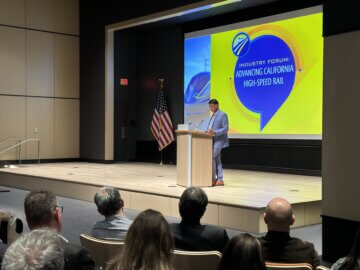
El director ejecutivo Ian Choudri se dirige a los asistentes al Foro Industrial 2025 de la Autoridad.
Para dar inicio al año 2025, la Autoridad organizó un exitoso foro industrial de dos días con más de 400 participantes que representaban a empresas de sistemas ferroviarios, construcción, diseño, tecnología y finanzas. Expertos e innovadores de todo el país, e incluso algunos de otros países, se reunieron con la Autoridad y brindaron valiosos comentarios para fundamentar decisiones cruciales y definir el futuro del proyecto. La Autoridad continúa recabando opiniones y asesoramiento del sector privado para definir su estrategia de adquisiciones, incluyendo la emisión de un Solicitud de Manifestaciones de Interés esta primavera en relación con los aspectos comerciales, financieros, técnicos y de adquisiciones de una estrategia de entrega preferida para el proyecto del tren de alta velocidad.
En mayo, el director ejecutivo Choudri participó en la Conferencia Anual de la Asociación de Ferrocarriles de Alta Velocidad de Estados Unidos, celebrada en Washington, D.C. Su presentación, titulada «Impulsando el primer sistema ferroviario de alta velocidad en el suroeste de Estados Unidos», abarcó los avances logrados en el programa y los acuerdos con Brightline West y el Corredor Conjunto de Poderes del Alto Desierto para conectar el sistema ferroviario de alta velocidad estadounidense con el de ellos, creando así la primera red interestatal de alta velocidad del país.
En junio, el director ejecutivo Choudri fue uno de los oradores principales en el Seminario sobre Trenes de Alta Velocidad de la Asociación Estadounidense de Transporte Público (APTA) en San Francisco. Junto con ejecutivos de empresas de desarrollo e inversión, participó en el panel «Asociaciones Público-Privadas y Trenes de Alta Velocidad» ante una audiencia internacional de profesionales del sector ferroviario de pasajeros. El panel analizó las ventajas que las APP pueden aportar para acelerar y optimizar la ejecución de los distintos segmentos del programa, a la vez que se comercializan activos como trenes, estaciones, accesos a la vía, fibra óptica e inmuebles.
El director ejecutivo Choudri también ha estado conversando con miembros de los medios de comunicación de todo el estado sobre los próximos pasos para el tren de alta velocidad, tanto a nivel local como estatal. Artículos recientes en el San Jose Mercury News aquí y aquí, artículos editoriales positivos en el Fresno Bee aquí, aquíy aquíy artículos extensos en Forbes, KTLA, Blog de calles, y el Crónica de San Francisco demostrar el compromiso de Choudri de compartir la nueva dirección del proyecto con el público.
Con un nuevo liderazgo llega una nueva visión para el tren de alta velocidad. El director ejecutivo, Choudri, ha recorrido el estado y el país, interactuando con el público, los medios de comunicación y las partes interesadas clave para comunicar esta visión innovadora. Con energía renovada y una perspectiva fresca, el programa avanza para ofrecer un sistema de transporte moderno y limpio para todos los californianos.
La autoridad acelera el cronograma para la instalación ferroviaria de 2026.
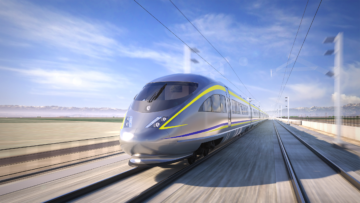
Con el inicio de la construcción de vías y sistemas previsto para el próximo año, el progreso del tren de alta velocidad de California no muestra signos de desaceleración.
El 28 de agosto, la Junta Directiva de la Autoridad aprobó la emisión de invitaciones a licitar para el suministro de vías férreas de alta velocidad y otros componentes necesarios del sistema, un hito importante que acelera la construcción de vías y sistemas, prevista para comenzar el próximo año. Esta aprobación permite a los fabricantes estadounidenses presentar ofertas competitivas en seis licitaciones distintas, justo cuando la Autoridad está a punto de finalizar su proyecto de terminal ferroviaria sur en el condado de Kern.
Los materiales necesarios para la construcción de la vía férrea a lo largo del tramo de 191 kilómetros (119 millas) serán financiados en su totalidad por el estado e incluyen diversos productos, como rieles, traviesas, postes para el sistema de catenaria, cable de fibra óptica y balasto EN, con un costo total aprobado de 1.507 millones de dólares, distribuido en varios contratos. Todos los materiales serán de nueva fabricación y cumplirán con las leyes «Buy America» y «Build America, Buy America». La convocatoria de licitaciones está programada para comenzar en agosto de 2025 o posteriormente. Puedes obtener más información sobre esta acción aquí..
La autoridad finaliza dos estructuras más
Durante el verano, la Autoridad finalizó dos estructuras, alcanzando las siete terminadas este año y casi 60 completadas en el Valle Central desde el inicio de la construcción.
El 21 de agosto se finalizó la construcción del paso a desnivel de la Avenida 88 en el condado de Tulare. Esta estructura, construida por la empresa conjunta Dragados-Flatiron, mejorará el acceso para maquinaria agrícola, personal de emergencias y vehículos. El paso a desnivel, ubicado cerca de la Ruta Estatal 43, tiene 148 metros de largo y más de 9,75 metros de ancho. Puedes obtener más información sobre esta estructura aquí..
A finales de julio, la Autoridad y líderes locales y estatales celebraron la finalización del proyecto de separación de niveles de la calle Tulare con una ceremonia de inauguración en el histórico barrio chino de Fresno. El paso inferior ahora permite que el tráfico vehicular circule a más de seis metros por debajo de las vías del tren Union Pacific y del futuro tren de alta velocidad. Funciona como una carretera de dos carriles de más de 300 metros de largo y 18 metros de ancho, con acceso peatonal y ciclovías para residentes y ciclistas, lo que mejora la seguridad y reduce las emisiones de gases de efecto invernadero y contaminantes nocivos para la salud. Este proyecto es particularmente significativo, ya que reconecta el barrio chino de Fresno con el centro de la ciudad tras décadas de separación, mejorando el acceso y la movilidad, impulsando el crecimiento económico a largo plazo y sentando las bases para el tren de alta velocidad. Puedes obtener más información sobre esta estructura aquí..
| ACTUALIZACIONES DE SOCIOS |
Asociaciones y progreso en el norte de California
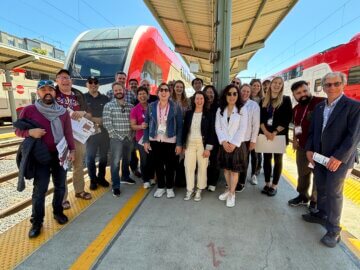
En la Conferencia Ferroviaria APTA de 2025, profesionales del transporte de todo el mundo pudieron viajar en el nuevo sistema Caltrain electrificado, financiado en parte por la Autoridad.
Las alianzas y los avances quedaron patentes cuando ejecutivos del sector del transporte de todo el mundo experimentaron de primera mano el proyecto del tren de alta velocidad en dos visitas separadas durante la Conferencia Ferroviaria de la Asociación Estadounidense de Transporte Público (APTA) de 2025 en San Francisco.
El sábado por la mañana, una visita guiada sobre desarrollo urbano orientado al transporte público recorrió el Centro de Tránsito Salesforce, incluyendo la estación subterránea ya construida, la futura terminal del Tren de Alta Velocidad de California (Caltrain), así como las casi 19 hectáreas de viviendas, comercios y espacios abiertos que la rodean. Este barrio se ha transformado gracias a un ambicioso programa de planificación y desarrollo denominado Programa Transbay.
Las visitas guiadas estuvieron a cargo de Adam Van de Water, director ejecutivo de la Autoridad Conjunta de Transbay (TJPA), propietaria y operadora del Centro de Tránsito, la futura sede del tren de alta velocidad en San Francisco.
Van de Water lo calificó como “uno de los desarrollos orientados al transporte público más exitosos del país”. Explicó: “Durante las últimas dos décadas, la TJPA y sus socios han transformado hectáreas de estacionamientos y rampas de autopista en el nuevo vecindario más emocionante de San Francisco, con nueve operadores de transporte público, millones de pies cuadrados de nuevo desarrollo y que ahora alberga a más de 15.000 nuevos residentes”.
Más tarde ese mismo día, 25 asistentes a la conferencia viajaron en el recién electrificado sistema Caltrain y visitaron el Centro de Tránsito Salesforce, la futura terminal norte del tren de alta velocidad. La inversión de la Autoridad, de más de 1.500 millones de dólares, para la electrificación del corredor de Caltrain contribuyó a financiar este proyecto y a preparar el corredor para el futuro servicio de tren de alta velocidad.
Sherri Bullock, directora del Programa de Modernización de Caltrain, describió los beneficios. «La electrificación nos permite compartir la infraestructura de forma segura. Aumenta la capacidad del corredor al permitir una aceleración más rápida, tiempos de parada más cortos y mayor frecuencia de servicio», a la vez que reduce las emisiones, explicó. «Esto supone un hito importante no solo para Caltrain, sino para el futuro del ferrocarril moderno e integrado en toda California».
El recorrido comenzó a las 4th El viaje comenzó en la estación King y continuó hasta la estación Millbrae. Entre los puntos destacados se incluyeron cuatro túneles históricos centenarios en San Francisco y el proyecto del Centro de Mantenimiento Ligero del Norte de California en Brisbane. Los asistentes conocieron los diferentes tipos de cruces ferroviarios, la compleja infraestructura que rodea el Aeropuerto Internacional de San Francisco y las nuevas viviendas que se están construyendo cerca de las estaciones. John Litzinger, de la firma HNTB, aportó su experiencia técnica a las presentaciones y el debate.
| ACTUALIZACIONES DE DIFUSIÓN |
Estudiantes de transporte recorren los aspectos más destacados del tren de alta velocidad
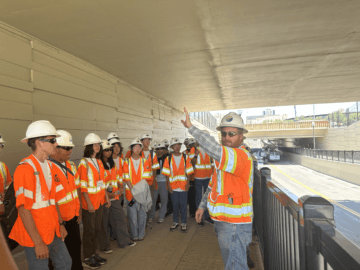
En el Valle Central, los estudiantes de MiSTA pudieron ver de cerca las estructuras del tren de alta velocidad en una visita guiada a la construcción dirigida por personal de la Autoridad.
“¿Dónde se estableció el récord de velocidad máxima en tren de alta velocidad, a casi 357 millas por hora?” Sin demora, varios estudiantes de la Academia de Transporte de Verano Mineta (MiSTA) dieron la respuesta: “Francia: el TGV”.
Es evidente que los estudiantes de secundaria —futuros líderes del transporte— sienten pasión por el tren de alta velocidad al observar las estructuras del proyecto de tren de alta velocidad de California que se está construyendo en el Valle Central.
El viaje forma parte de un programa práctico de tres semanas para estudiantes interesados en el transporte y áreas afines en el Instituto de Transporte Mineta (MTI) de la Universidad Estatal de San José. Una característica clave de MiSTA son las visitas guiadas a las instalaciones y sistemas de transporte, como aeropuertos y estaciones de tren.
Daniel Heine, de la operadora ferroviaria alemana Deutsche Bahn (DB), dio inicio a la visita a las obras en el Valle Central con una sesión informativa para los 28 estudiantes que viajaban en autobús desde San José el 16 de julio. DB es la operadora principal de trenes de la Autoridad, con responsabilidades que incluyen la planificación estratégica del servicio ferroviario y la integración del sistema. Heine abordó cuestiones técnicas y de política para los estudiantes. Hizo hincapié en la seguridad de las operaciones ferroviarias y los beneficios ambientales del tren de alta velocidad.
El oficial de información pública de la Autoridad, Augie Blancas, dirigió el recorrido y la sesión informativa en Fresno, recordando a los estudiantes: “Visitaremos una obra en construcción activa, y la seguridad es siempre nuestra máxima prioridad”. Las instrucciones de seguridad se repitieron antes de cada parada.
Luego, los estudiantes se dirigieron al paso subterráneo de la calle Tulare, que discurre por debajo del centro de Fresno, antes de visitar la parte superior del viaducto Cedar, al sureste. En el paso subterráneo, personal de la Autoridad les explicó las técnicas utilizadas en la construcción con hormigón y la importancia del drenaje en las estructuras subterráneas.
El punto culminante de la visita fue el ascenso al viaducto Cedar, que tiene más de 1128 metros de longitud y más de 12 metros de ancho. Las charlas informativas abarcaron la historia de la construcción y los detalles de diseño del lugar, así como las prácticas de seguridad para escalar una infraestructura tan imponente.
La academia de 2025 fue financiada por el programa de subvenciones Consolidated Rail Infrastructure and Safety Improvements (CRISI) de la FRA, que está dedicado a mejorar la seguridad, la eficiencia y la fiabilidad del transporte ferroviario interurbano de pasajeros y mercancías.
“Queremos que estos estudiantes aprendan directamente de los ingenieros, planificadores y personal de divulgación y comunicación sobre todo lo que implica la construcción de un megaproyecto de infraestructura”, dijo Alverina Weinardy, directora de operaciones de MTI. “Al brindarles una visión interna del progreso del tren de alta velocidad, estamos inspirando a la próxima generación a seguir carreras en el sector del transporte que dan forma a cómo nos movemos y cómo vivimos.
Resumen de las actividades de divulgación en el sur de California
Visita de bienvenida para estudiantes en prácticas del consorcio K12 Foothill en escuelas secundarias
Este verano, el equipo del sur de California dio la bienvenida a los pasantes de secundaria del Consorcio K12 Foothill de los distritos escolares unificados de Charter Oak, Monrovia, Duarte y Azusa para su primera visita de incorporación a la Autoridad como parte de sus proyectos estudiantiles de verano.
Su viaje comenzó con una visita guiada a la Estación Union de Los Ángeles (LAUS), dirigida por Jared Nigro, director de operaciones de la Fundación del Patrimonio Ferroviario de Los Ángeles, quien compartió la rica historia de la estación y su papel en el legado ferroviario de California. Posteriormente, los estudiantes almorzaron y exploraron la exposición actual de la Autoridad en Phillipe the Original, el histórico restaurante de sándwiches franceses frente a LAUS, para ver la muestra en la sala de trenes, mientras colaboraban en el rediseño que una estudiante en prácticas diseñó en colaboración con el personal de la Autoridad como parte de su proyecto estudiantil, el cual se estrenará en septiembre. El día concluyó en la oficina de la Autoridad en el sur de California, donde los estudiantes aprendieron más sobre el proyecto estatal y las diversas oportunidades profesionales. Para obtener más información sobre los proyectos de estos estudiantes, haga clic aquí..
Feria de empleo de la Biblioteca Pública de Los Ángeles
Este verano, en la feria de empleo de la Biblioteca Pública de Los Ángeles, el equipo de SoCal conectó con más de 50 personas en busca de trabajo, deseosas de conocer el proyecto de tren de alta velocidad de California. El personal de la Autoridad informó sobre el progreso del proyecto y conversó sobre las trayectorias profesionales y las oportunidades disponibles para quienes estén interesados en oficios especializados. La Autoridad compartió información sobre las oportunidades que ofrece el Programa de Capacitación Previa al Aprendizaje del Valle Central, y los asistentes se mostraron entusiasmados por conocer más sobre las futuras oportunidades laborales en el sector del tren de alta velocidad y formularon numerosas preguntas sobre las trayectorias profesionales. El evento contribuyó a generar entusiasmo y animó a la comunidad a informarse más sobre el proyecto y cómo prepararse para formar parte de la transformación histórica del panorama del transporte del estado.
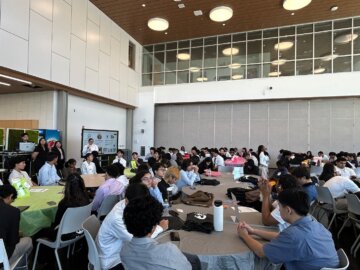
En la ceremonia de graduación del programa TCAP del Metro de Los Ángeles, los estudiantes recibieron una presentación sobre el estado del proyecto de tren de alta velocidad de California a cargo del personal de la Autoridad.
Presentación «I Will Ride» – Programa de la Academia de Carreras de Transporte del Área Metropolitana de Los Ángeles (TCAP)
En la ceremonia de graduación del programa TCAP del Metro de Los Ángeles de este año, el personal de la Autoridad del Sur de California (SoCal Authority) presentó a más de 200 estudiantes en prácticas información sobre el futuro del tren de alta velocidad. Se destacó el impacto del proyecto en el transporte, la sostenibilidad y las futuras oportunidades profesionales en todo el estado.
Por primera vez en el sur de California, una estudiante de secundaria en prácticas presentó al grupo su experiencia trabajando con el personal de la Autoridad del Sur de California este verano, colaborando en el rediseño del restaurante Phillipe the Original, que alberga la actual exposición del museo de la Autoridad en la sala de trenes. Esto permitió a los estudiantes conocer mejor esta oportunidad única a través de su experiencia, mientras que ellos mismos formularon preguntas al personal de la Autoridad sobre planificación, construcción y preparación profesional. Los becarios del programa TCAP se mostraron entusiasmados por aprender más sobre el proyecto y la experiencia de la estudiante, y expresaron su interés por el futuro del tren de alta velocidad.
Este proyecto fue posible gracias al programa de participación estudiantil «I Will Ride» de la Autoridad, que ofrece a los estudiantes la oportunidad de explorar carreras en el transporte ferroviario de pasajeros y facilita actividades que vinculan la educación con la preparación para el mundo laboral. ¡Visiten la exposición en Phillipe's!
Archivo del boletín All Aboard
- Boletín informativo All Aboard de otoño de 2024
- Boletín informativo All Aboard del verano de 2024
- Boletín informativo All Aboard de primavera de 2024
- Boletín informativo Todos a bordo del invierno de 2024
- Boletín informativo Todos a bordo de otoño de 2023
- Boletín informativo Verano 2023 Todos a bordo
- Boletín informativo Todos a bordo primavera de 2023



